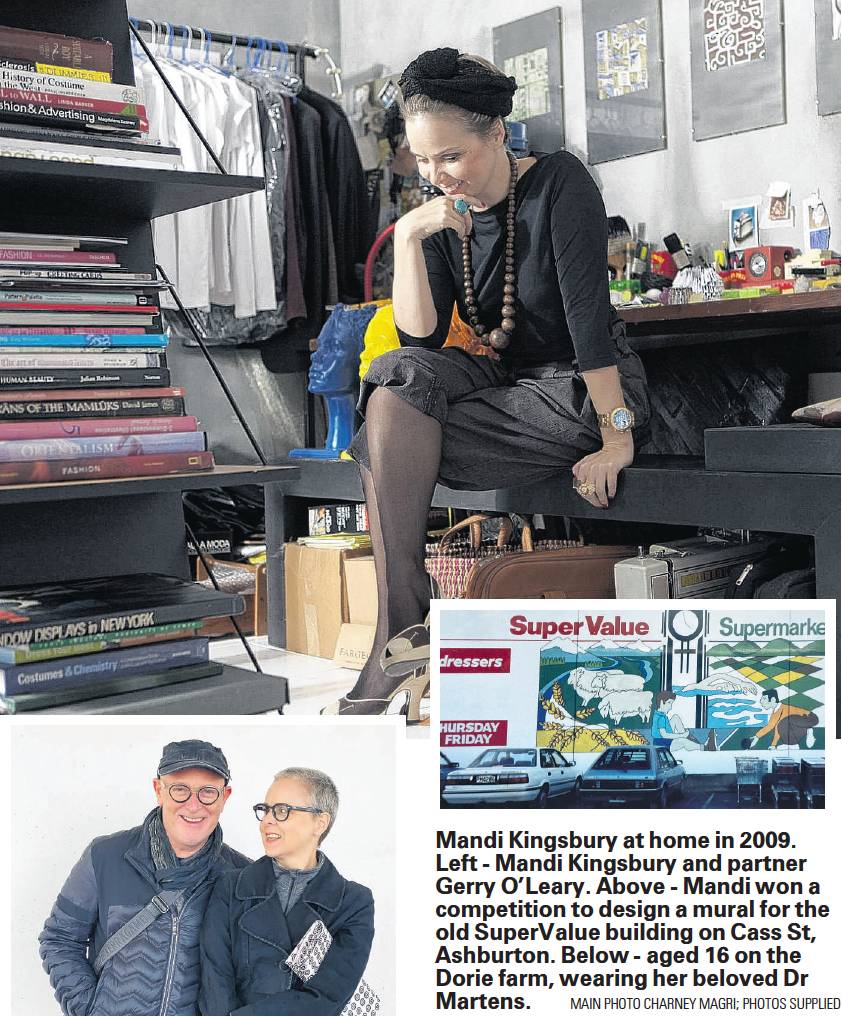
Mandi Kingsbury grew up on the family farm at Dorie, with parents Kelly and Barbara and her two older sisters Nikki and Jo.
She attended Dorie School and Ashburton College, before heading off to complete a diploma in textile design at Wellington Polytechnic.
Diagnosed with multiple sclerosis in about 2000, she died last month at the age of 53 after suffering a severe attack of the chronic disease while she was in Dubai.
Kelly and Barbara, who now live in Ashburton, are remembering the daughter who made them proud as she left home to fulfil her childhood dream of working in fashion.
‘‘She seemed to spend a lot of time sketching and colouring in when she was tiny,’’ Barbara said.
As a teenager she made unique items from clothing bought at op shops, while a pair of black Dr Martens were ‘‘the love of her life’’.
She had also been ‘‘very practical’’ on the farm, enjoying helping her dad outside and in his workshop. At the age of about 14, she took to welding in the workshop, making many sculptures.
Growing up, she had also been ‘‘mad on the animals’’, liking stock and caring for family pets. The latter included a small collection of cats, which Kingsbury added to one night when she came home from babysitting.
‘‘Here was a kitten looking out the front of her blouse. We had about three or four cats as it was,’’ Barbara said.
While at Ashburton College, Kingsbury won an Ashburton mural design competition. Her creation was painted on to the former SuperValue building on Cass St.
It was a taste of great things to come. Kingsbury won the World of Wearable Art (WOW) Supreme Award for her entry Magpie in 1994.
This led to a job offer by Dubai couture house Arushi. Soon she was designing dresses for Emirati women, including the United Arab Emirates royal family.
She spent the rest of her life mostly between Canterbury and Dubai, working as a fashion and jewellery designer and stylist in the Middle East, New Zealand, and other countries.
She re-entered WOW in 2007, to demonstrate her MS diagnosis did not limit her, and came runner-up.
This invigorated her career further. She became a sought-after international stylist; her portfolio included work for Chanel, Swarovski, Harvey Nichols, Estee Lauder, and others.
Talking to MiNDFOOD in 2010, Kingsbury shared the experience of having a high-powered career while struggling with MS.
Her symptoms had started soon after moving to Dubai.
‘‘I fell in love with Dubai immediately. The work hours were long and I felt inspired, but for some reason was constantly exhausted. My doctor told me it was the change of climate, so I assumed I just needed to pull my socks up and get on with this new life. So I did,’’ Kingsbury said in the interview.
‘‘After I finished my contract with Arushi, I travelled to Rome and Milan hunting opportunities, but returned to Dubai and took on contracts designing and conceptualising uniforms for multi-national corporations,’’ she said.
‘‘I put my constant fatigue, headaches and eye problems down to exhaustion from work stress. Doctors were little help; one simply told me not to think about the exhaustion, aching and tingling and gave me antidepressants.
‘‘After the diagnosis, I realised I didn’t have to be so tough on myself which was quite lovely.’’
She was running a fashion design consultancy in Dubai and studying for a Master of Design degree in Wellington.
‘‘I immediately gave up the big contract fashion design work and don’t regret it. I think it is important to listen to our bodies but not give up on our dreams, we can adapt our dreams.’’
She went into freelance fashion styling, working in India, Cape Town, Egypt, Croatia and New Zealand.
‘‘I love the choice and can now manage my work ratio to how I am coping with MS.’’
But in June this year she was admitted to hospital in Dubai, after her symptoms worsened.
During her stay, she suffered a severe relapse which left her paralysed. She was unable to eat, drink or speak, although was aware of her surroundings.
In late July her family brought her home to New Zealand. The Airbus A380 flight required 11 seats to accommodate her stretcher and support crew.
She was admitted to Christchurch Hospital, then Nurse Maude Hospice before passing away on September 7. She was surrounded by her family and partner, Irish architectural photographer Gerry O’Leary.
O’Leary shared a tribute, saying ‘‘She has now begun her next creative chapter, crafting her heavenly art alongside the angels’’.












